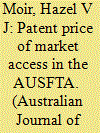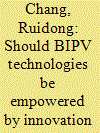|
|
|
Sort Order |
|
|
|
Items / Page
|
|
|
|
|
|
|
| Srl | Item |
| 1 |
ID:
121348


|
|
|
|
|
| Publication |
2013.
|
| Summary/Abstract |
Utilities are increasing their investment in smart grid technologies because of the rising demand for electricity, the aging transmission and distribution infrastructure in developed countries and the need for real-time visibility of energy supply and demand to optimize service reliability and cost. Government policies are contributing to this rising investment in the smart grid in many countries around the globe. Using Rothwell and Zegveld's innovation policy framework as a starting point, this paper compares innovation policy in smart grids across the Pacific; specifically, China and the USA. This research describes the policy tools used by both countries and presents results that indicate national preferences for innovation policy that differ in the ways in which they are linked with the state of the power system. China has preferred to use "supply-side policy," which focuses on "public enterprise, scientific and technical development and legal regulation." The USA has preferred to use "environmental-side policy," which focuses on "scientific and technical development, financial, political and public enterprise." This paper also describes in detail a number of innovation policies being pursued in the smart grid industry in both China and the USA.
|
|
|
|
|
|
|
|
|
|
|
|
|
|
|
|
| 2 |
ID:
186498


|
|
|
|
|
| Summary/Abstract |
The role of publicly funded organisations in implementing accelerated low carbon innovation policy is receiving increasing attention. Due to different national contexts and priorities however, policy makers face high levels of complexity in understanding what organisational approaches might best suit their aims. This paper develops a set of ten principles for accelerated innovation organisation design, which seek to provide policy makers with a tool to better understand the interplay of different design features on innovation outputs. The principles are applied to a comparative case study of the Energy Technologies Institute (ETI), United Kingdom (UK), and the Advanced Research Projects Agency– Energy (ARPA-E), United States (US). Results demonstrate that the design of the ETI, which embedded incumbent industry actors and engaged a narrower set of staff competencies, caused it to prioritise un transformative innovation, contrary to its initial mission. Conversely, the operational approach of ARPA-E has created an entrepreneurial, flexible approach to pursuing transformative innovation. The organisation however lacks long term stability in a changing political environment. Conclusions explore the implications of these results for policy makers seeking to design organisations that are effective in accelerating low carbon innovation.
|
|
|
|
|
|
|
|
|
|
|
|
|
|
|
|
| 3 |
ID:
162345


|
|
|
|
|
| Summary/Abstract |
Recent climate change initiatives, such as ‘Mission Innovation’ launched alongside the Paris Agreement in 2015, urge redoubled research into innovative low carbon technologies. However, climate change is an urgent problem – emissions reductions must take place rapidly throughout the coming decades. This raises an important question: how long might it take for individual technologies to emerge from research, find market opportunities and make a tangible impact on emissions reductions? Here, we consider historical evidence for the time a range of energy supply and energy end-use technologies have taken to emerge from invention, diffuse into the market and reach widespread deployment. We find considerable variation, from 20 to almost 70 years. Our findings suggest that the time needed for new technologies to achieve widespread deployment should not be overlooked, and that innovation policy should focus on accelerating the deployment of existing technologies as well as research into new ones.
|
|
|
|
|
|
|
|
|
|
|
|
|
|
|
|
| 4 |
ID:
125689


|
|
|
|
|
| Publication |
2013.
|
| Summary/Abstract |
Algal biofuel is an emerging energy source that has the potential to improve upon the environmental benefits realized by conventional biofuels and contribute to the biofuels mandate set by the Renewable Fuel Standard (RFS). While there has been much research into producing fuel from algae, a commercial-scale facility has not yet been built. We examine two case studies of energy technology innovation in the United States, first generation biodiesel and solar photovoltaics (PV), using the technological innovation system (TIS) framework to provide lessons and inform the path forward for commercializing algal biofuel. We identify five event types that have been the most influential to these innovation processes: changing expectations, technology development, demonstration projects, policy targets, and government subsidies. Some algal biofuel demonstration projects have occurred, but despite falling under the mandates set forth in the RFS (a policy target), algal biofuels do not currently receive production subsidies. The main finding from the case study analysis is that government interventions have significantly influenced the innovation processes of first generation biodiesel and solar PV and will likely be key factors in the commercialization of algal biofuel.
|
|
|
|
|
|
|
|
|
|
|
|
|
|
|
|
| 5 |
ID:
103367


|
|
|
|
|
| Publication |
2011.
|
| Summary/Abstract |
Research on conditions to develop new innovations within emerging renewable energy industries is often done with a national focus. However, recent research on international entrepreneurship has revealed that firms operate on international levels very early in their life time. Thus, based on former research on international entrepreneurship and case examples, we build the propositions that firms in the marine energy industry use internationalization as a strategy to overcome industry barriers. Our primary source of data is a unique dataset from a global survey of all the companies in the marine energy industry who are aiming to commercialize a wave or tidal energy device.
This paper is organized in two steps: first we identified the most challenging industry barriers perceived by companies. Second we use these to form propositions which we assess through empirical data. The two most challenging barriers perceived by the companies are need for capital and need for supportive political schemes. Our findings reveal that internationalization certainly is a common strategy to access capital and attractive support schemes in foreign countries. The early internationalization has implications for researchers, managers and policy makers.
|
|
|
|
|
|
|
|
|
|
|
|
|
|
|
|
| 6 |
ID:
124892


|
|
|
|
|
| Publication |
2013.
|
| Summary/Abstract |
Many studies raise doubts about the effectiveness of the institutions, programmes and instruments that shape the Chinese national innovation system. This article scrutinizes central-local interactions in the national Torch Programme that has governed a large group of high-technology zones since 1988. The Torch Programme's procedural practices challenge widely shared assumptions about the dirigiste character of Chinese innovation policy. It combines centralized definition of programme objectives with extensive local implementation experiments. As three case studies demonstrate, bottom-up policy innovations are effectively fed back into national programme adjustments and into horizontal policy diffusion. The array of organizational patterns and promotional instruments that emerges from competitive "experimentation under the shadow of hierarchy" (ESH) goes way beyond what could have been initiated from top down. We hypothesize that the procedural strengths displayed in the Torch Programme may provide better indicators of future innovative potential in China's high-technology zones than retrospective statistical indices and benchmarks that are derived from OECD experience.
|
|
|
|
|
|
|
|
|
|
|
|
|
|
|
|
| 7 |
ID:
140723


|
|
|
|
|
| Summary/Abstract |
New generation trade agreements reach far behind borders, affecting many areas of domestic policy not previously associated closely with trade. One of the most uneasy of these areas is intellectual property, particularly patent monopolies. The USA has been a major force behind the extended reach of patent monopolies using preferential trade agreements. The patent and data exclusivity provisions of the AUSFTA were proposed by the USA. This paper provides detailed evidence about how such ‘TRIPS+’ policies compare to a balanced patent policy—one equally favouring creators and users of technology. Australia has never had an active patent agenda, but since AUSFTA has been willing to accept in its bilateral and regional trade deals highly prescriptive rules that tie the hands of future governments. The overall trend has thus been toward increasing imbalance, with Australian patent policy now having a very broad reach and very low eligibility standards. This particularly affects the cost of medicines, where large numbers of relatively uninventive patents surround a blockbuster drug and delay the market entry of generic alternatives. In addition to outlining the costs of Australia’s current patent policy approach, the paper concludes by highlighting a more balanced and less costly way forward.
|
|
|
|
|
|
|
|
|
|
|
|
|
|
|
|
| 8 |
ID:
090965


|
|
|
|
|
| Publication |
2009.
|
| Summary/Abstract |
This article considers the impact of the Agreement on Trade-Related Aspects of Intellectual Property Rights (TRIPS) in developing countries. After an initial phase of "paper compliance" with TRIPS, followed by efforts to manage the welfare costs of its implementation, a number of developing countries are looking at ways to optimize the implementation or reimplementation of the agreement to foster domestic competitiveness and innovation. One part of the equation involves attracting technology-intensive foreign direct investment. Another involves enhancing local innovation potential. Surfing the wave of outsourcing, which increasingly targets higher knowledge functions, a number of developing countries are becoming globally competitive innovators and displacing the geographical centres of innovation, with substantial political and economic impacts.
|
|
|
|
|
|
|
|
|
|
|
|
|
|
|
|
| 9 |
ID:
166558


|
|
|
|
|
| Summary/Abstract |
As new renewable energy applications, building-integrated photovoltaics (BIPV) systems have significant potential to facilitate energy transitions towards renewable energy in highly urbanized countries, where large areas of land for developing large-scale solar or wind farms are limited. Government policy plays a significant role in nurturing and protecting energy innovations at the early development stage, such as BIPV. However, various actors could have divergent views on the policies for energy innovations, and policymakers need to consider these views in policymaking to avoid potential failures in policy implementation. By taking BIPV as an example, this study aims to reveal stakeholders' different perspectives on the required innovation policies for new energy technologies based on Q methodology. The results indicate even though stakeholders share similar views on some aspects of BIPV policies, four significantly distinct policy perspectives on BIPV exist in stakeholders' mindsets, including supervisory support, intensively investigate, cautiously stimulate and proactively promote. These policy perspectives require significantly different approaches to promote BIPV, which indicates the complexity in formulating one set of policy mix catering for the various mindsets of stakeholders. This study has both theoretical contributions to innovation policy mix for energy transitions, and policy implications for promoting energy innovations, especially BIPV worldwide.
|
|
|
|
|
|
|
|
|
|
|
|
|
|
|
|
| 10 |
ID:
132720


|
|
|
|
|
| Publication |
2014.
|
| Summary/Abstract |
Innovation is fundamental to a space agency's mission. Yet, the industry's current dominant approach to new technology development - concerted investment in step-changes in capabilities to support a particular application - contradicts the conventional wisdom of innovation theory. In order to understand why, this paper uses a unique empirical case study, in which exogenous historical circumstances created unexpected additional opportunities for technology investment, to explore the merits of this approach. The value of follow-on periods of R&D is assessed in terms of simple marginal returns, implications for workforce dynamics and the interaction of mission sequencing and technology strategy. The analysis reveals an important contingency between mission paradigm and the value of follow-on investment. Specifically, while marginal performance improvements can be achieved at lower costs, their value depends on the availability of an appropriate mission opportunity. In the current paradigm, the risk of obsolescence is high compared to the potential benefit. However, if a new small mission, frequent flights, paradigm were to take hold, there may be great value in refocusing R&D strategy on later round improvements.
|
|
|
|
|
|
|
|
|
|
|
|
|
|
|
|
| 11 |
ID:
149911


|
|
|
|
|
| Summary/Abstract |
We use biofuel patents as a proxy for biofuel innovation. Through use of natural language processing and machine-learning algorithms, we expand patent classification capabilities to better explain the history of biofuels innovation. Results indicate that after the initial establishment of the U.S. biofuel industry, there were two surges in biofuel innovation: 1995–2000, characterized by heavy patenting by 1st generation (food-based) biofuel firms; and 2005–2010, characterized by a second surge of innovation by those same large firms, complemented by a large number of biotechnology firms producing a relatively small number of 2nd generation biofuel patents. Our analysis corroborates the widespread understanding that the first surge in biofuel innovation was linked to innovations in agriculture, and that the second surge of biofuel innovation was driven by demand-pull policies mandating and incentivizing biofuels. But the slow emergence of a 2nd generation cellulose-based biofuels industry, far slower than called for by policy, suggests that technology-push policies more focused on R&D and investment may be needed to accelerate the commercialization of 2nd generation biofuels.
|
|
|
|
|
|
|
|
|
|
|
|
|
|
|
|
| 12 |
ID:
158447


|
|
|
|
|
| Summary/Abstract |
This article surveys the body of available evidence regarding the spill-over effects of defence R&D. It reviews the routes through which defence R&D spills over to the economy with positive externalities – in terms of new products, technologies or processes; the barriers that impede or block such a process; potential negative repercussions, and the measure of such effects. The main conclusion is that the uncertainty of these effects, and the inaccurate appraisal of their value, hardly supports informed decisions concerning defence R&D policies.
|
|
|
|
|
|
|
|
|
|
|
|
|
|
|
|
|
|
|
|
|